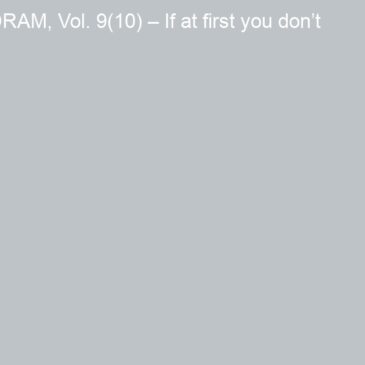To measure the availability of alcohol to underage consumers, researchers and policy-makers commonly examine non-compliance rate – the percent of stores selling alcohol in a given area at which a minor is able to purchase alcohol because stores are not complying with purchasing laws (Freisthler, Gruenewald, Trena et al., 2003; Paschall, Grube, Black et al., 2007; Toomey, Komro, Oakes et al., 2008). If non-compliance rates in a given area are low, it is generally believed that alcohol is not available to minors. However, because adolescents are generally free to visit as many alcohol outlets as they want and share information about outlets willing to sell to them, compliance rate may not be the best measure of availability. This week’s DRAM reviews a study that suggests a new type of variable to assess alcohol availability to minors (VanHoof & Gosselt, 2013).
Methods
The researchers measured the non-compliance rate (i.e., selling to minors, thus failing to comply with the law) of alcohol outlets as well as a time-based measurement of alcohol availability over the span of 3 weeks.
- The researchers recruited a total 24 students aged 14 to 15 (12 boys and 12 girls) from schools in two different regions of the Netherlands.
- Students were selected based on their knowledge of the neighborhoods in the research areas as well as their appearance as “average”
looking adolescents.
- Students were selected based on their knowledge of the neighborhoods in the research areas as well as their appearance as “average”
- In Experiment 1, the researchers calculated alcohol outlet non-compliance rates in the traditional way by asking 4 of the selected students
to attempt to purchase a beer from 203 randomly selected outlets. - In Experiment 2, the researchers calculated alcohol availability by asking the 20 remaining students to attempt to purchase alcoholic
beverages on 10 separate trips each to alcohol outlets.- In each neighborhood area, students were free to choose which establishments to visit; they were allowed to visit multiple stores or move on to their next area/trip if earlier purchase attempts failed. Students made a total of 198 trips to buy alcohol.
- The researchers measured how many times students successfully purchased alcohol (1) on their first attempt within a trip; and (2)
on their 2nd, 3rd, or 4th attempt within a trip; as well as how many attempts were required for their first alcohol purchase and how long it took to complete that purchase.
|
|
Successful beer purchase |
| Experiment 1: Traditional non-compliance rate |
|
| Stores selling to minors | 165/203 outlets (81.3%) |
| Experiment 2: Alcohol availability to minors |
|
| Success on 1st attempt within a trip | 150/198 trips (75.8%) |
|
Success on 2nd, 3rd, or 4th attempt within a trip |
23/198 trips (11.6%) |
| Successful beer purchase within a trip | 173 /198 trips (87.4%) |
Figure. Non-compliance rate and availability (adapted from VanHoof & Gosselt, 2013). Click image to enlarge.
Results
- The traditional non-compliance rate was 81.3%; 165 of 203 stores sold to minors.
- However, the combined alcohol availability rate was higher; when students were allowed to visit more than one store to buy alcohol, 87.4% of trips were successful (see Figure).
- On average, it took the students just under 12 minutes to make their first alcohol purchase, and all were able to make their first alcohol purchase within three attempts.
Limitations
- The study was performed in the Netherlands. This greatly limits our ability to generalize the results to the US because in the
Netherlands, the legal drinking age is much lower at 16 years old. - It is not illegal for minors to attempt to purchase alcohol; only the sale of it is illegal. In most US states, it is also illegal to purchase alcohol as a minor (National Institute of Alcohol Abuse and Alcoholism, n.d.).
- The non-compliance rate in the study is very high (81.3%) compared to rates in the United States (34%-39%) (Freisthler et al., 2003; Paschall et al., 2007; Toomey et al., 2008), suggesting more lax attitudes toward selling to minors in the Netherlands.
Discussion
This study suggests that the traditional non-compliance rate does not fully capture the extent to which alcohol is available to minors. The authors suggest that alcohol availability is a function of the number of outlets that an adolescent is willing to visit and prior knowledge of store’s tendency to sell to minors. Additionally, the authors suggest that using time to purchase and outlet density as part of an availability measure could add to our understanding of alcohol availability. Even if the compliance rate is low in an area, alcohol might still be readily available if many outlets are nearby and minors are prepared to make many attempts. With greater communication through text-message, Facebook, Twitter, and other applications, it is quite likely that actual alcohol availability is higher than previously thought.
-Jed Jeng
What do you think? Please use the comment link below to provide feedback on this article.
References
Freisthler, B., Gruenewald, P. J., Trena, A. J., & Lee, J. (2003). Evaluating alcohol access and the alcohol environment in neighborhood areas. Alcohol, Clinical and Experimental Research, 27(3), 477-484.
National Institute of Alcohol Abuse and Alcoholism. (n.d.). Underage Drinking: Underage Purchase of Alcohol. Alcohol Policy Information System, from http://alcoholpolicy.niaaa.nih.gov/Underage_Purchase_of_Alcohol.html
Paschall, M. J., Grube, J. W., Black, C., Flewelling, R. L., Ringwalt, C. L., & Biglan, A. (2007). Alcohol outlet characteristics and alcohol sales to youth: results of alcohol purchase surveys in 45 Oregon communities. Prevention Science, 8(2), 153-159.
Toomey, T. L., Komro, K. A., Oakes, J. M., & Lenk, K. M. (2008). Propensity for illegal alcohol sales to underage youth in Chicago. Journal of Community Health, 33(3), 134-138.
VanHoof, J. J., & Gosselt, J. F. (2013). Underage alcohol sales–it only takes a minute: a new approach to underage alcohol availability. J Stud Alcohol Drugs, 74(3), 423-427.




